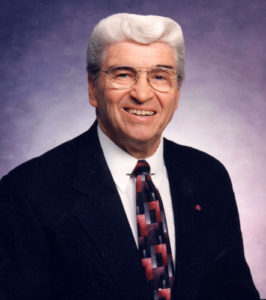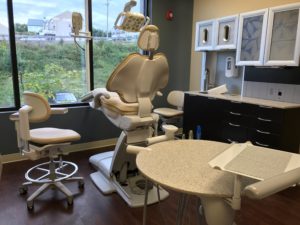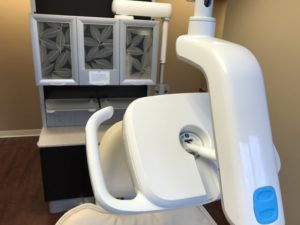By Sunshine Wiles-Gidley
The West Virginia University (WVU) School of Dentistry is joining forces with a philanthropic educational group to give the next generation of Mountaineers access to advanced dental equipment during their clinical instruction.
The Center for Research and Education in Technology, or CRET, is a nonprofit consortium of academics and industry. The organization essentially takes a dental school’s equipment wish list and turns it into reality by providing the most recently developed and technologically advanced materials, furnishings and patient care devices for dental operatories, dental labs and sterilization centers that most academic institutions cannot afford to purchase outright.

The innovation center is named in honor of Dr. W. Robert Biddington, former dean of the WVU School of Dentistry.
“By comparison, the new Dr. W. Robert Biddington Center for Dental Innovation is going to be a quantum leap forward from what we have to work with today,” says Anthony Borgia, D.D.S., M.H.A, dean of the WVU School of Dentistry. “Dental technology is changing just as rapidly as medical technology and maybe even faster in a number of areas. This facility will allow us to be an integral part of that change.”
A select group of dental industry manufacturers collaborates with academic leaders to comprise the CRET organization, whose mission is to get new products into current teaching and clinical environments. For example, WVU School of Dentistry students and faculty will have access to technology like intraoral cameras and combined two- and three-dimensional imaging capabilities similar to medical CAT scans that allow for examination of the entire head and neck regions.
Digital impression capability will eliminate the need for the patient to wait for the uncomfortable soft materials currently used today to harden in the mouth when creating an impression. In addition, digital impressions expedite the manufacturing of crowns. The process is completed within an hour by an onsite device that cuts the crown from a solid block of composite material, eliminating a second patient visit.
Even more importantly, various pieces of oral cancer screening equipment will make it easier to distinguish potentially cancerous lesions in a patient’s mouth from normal but questionable looking tissue.
At the end of their tour in the innovation center, each student user will provide direct feedback to the suppliers on the instruments and products they have just employed. In turn, the manufacturers will utilize those experiences and comments to help develop their next generation of materials and devices, which Borgia refers to as the proverbial win-win for all.
Lauren Yura, D.D.S, a 2015 graduate of the dentistry school, is the director of the Biddington Innovation Center, which is named for the school’s longest serving dean who also served as interim chancellor of the entire Health Sciences Center at WVU. Since July, Yura has overseen renovations and plans for the Suncrest Towne Centre clinic located along Route 705 in Monongalia County.
“The students really get to experience all these different materials independently and get to make up their minds about what they really like, what handles best in their hands and what works for their patients,” she says. “When they graduate, they’re better practitioners and clinicians, and they’re going to serve their patients a lot better.”
Each fourth year dental student will spend a two-week rotation mastering all that is new at the innovation center while at the same time treating their own patients in the state-of-the-art operatories.
Yura says choosing the initial products for the innovation center opening reminded her of being a child at Christmas.
“I get really excited about the materials,” she says. “We are trained on one type of composite. We are trained on one type of bonding system. With the CRET center, we give our students seven, eight or nine different types of composites to try along with multiple bonding systems and multiple cements. That is an opportunity not many students get.”
Borgia, a native of Plymouth, MA, came to Morgantown following his own studies at Boston College, the Georgetown University School of Dentistry, the University of Connecticut School Of Dental Medicine and Suffolk University and while serving in the U.S. Air Force Dental Corps. The founder of Cape Cod Endodontics, he was in private practice for 30 years before he left for academics in 2010.
“At WVU, we believe in going first and leading the nation,” he says. “With the opening of CRET, Morgantown will be the premier destination in the eastern U.S. for professionals to see and use the latest in dental technology. We will be one of only three CRET innovation centers anywhere in the U.S. and Canada. The opening of the innovation center will be a testament to our ability and commitment to be the very best in educating our students and in treating our patients. We have embraced this project with a huge amount of enthusiasm, and we intend our innovation center to be the flagship of all of them.”
CRET is an integral partner for innovation centers at Loma Linda University School of Dentistry in Loma Linda, CA, and the University of Missouri-Kansas City School of Dentistry in Kansas City, MO. Without CRET, spending well in excess of $500,000 to purchase the latest technology in oral health care would be out of the question for Borgia and his team, especially now in these times of extensive higher education funding cuts.
However, lacking essential technology that best serves the dental needs of the patients that prepares student doctors for delivering optimum preventative, restorative and surgical treatment in a state where oral health is considered poor at best is also not an option, according to Borgia.
Per capita, West Virginia ranks 47th in the nation, near the bottom of the list, for its number of practicing dentists as reported by WalletHub. WalletHub also ranked West Virginia 51st in overall oral health out of 50 states and the District of Columbia.
“CRET is comprised of a group of manufacturers that represent the very best in what being good corporate citizens is all about,” says Borgia. “Part of their motivation in that role is understanding that the best place for them to put their philanthropic efforts is into the areas that have the greatest needs and the fewest resources with which to address those needs. They have recognized that in West Virginia.”
 Yura believes this partnership will increase West Virginia patients’ well-being and begin to diminish the disparity in the state’s overall oral health care.
Yura believes this partnership will increase West Virginia patients’ well-being and begin to diminish the disparity in the state’s overall oral health care.
At a late September open house, CRET representatives joined dental suppliers and WVU School of Dentistry guests for a sneak peek at the innovation center, and in October, fourth-year dental students will begin to be introduced to and become acclimated to the new space and equipment.
WVU School of Dentistry faculty and student dentists treat more than 16,000 patients per year from all 55 counties on the Morgantown campus. Students, under faculty supervision, are expected to begin performing procedures in the Biddington Innovation Center in late October or early November.
Those same students provide care to all of the citizens of West Virginia through participating in rural rotations at 63 clinics, private practices and community centers across the state. The school reports dental and dental hygiene students performed 17,225 clinical procedures while treating 8,807 patients from July 1, 2016 to June 30, 2017.
“It will not just be a showcase, it will be instrumental in producing better health care outcomes,” says Borgia. “We have patients that drive three and four hours to seek our care. Our citizens look to WVU, not only for the best in medical and dental care but also for the best of all aspects of higher education, and they deserve nothing less. They expect us to be the innovators. By improving our ability to deliver high quality care through technology, we can render care to patients that will be second to none.”
 About the Author
About the Author
Sunshine Wiles-Gidley is the communications specialist for the WVU School of Dentistry and a graduate of the Reed College of Media at WVU. A broadcast journalism degree led to a decade-plus of television news reporting and anchoring in West Virginia, Tennessee and Pennsylvania as an education reporter covering K-12 issues and higher education news. Among a number of stories, she wrote and produced pieces on East Tennessee State University’s pharmacy school opening and shared coverage of simulation labs at the university’s medical school. The Preston County native also has multiple years of experience in radio news.



